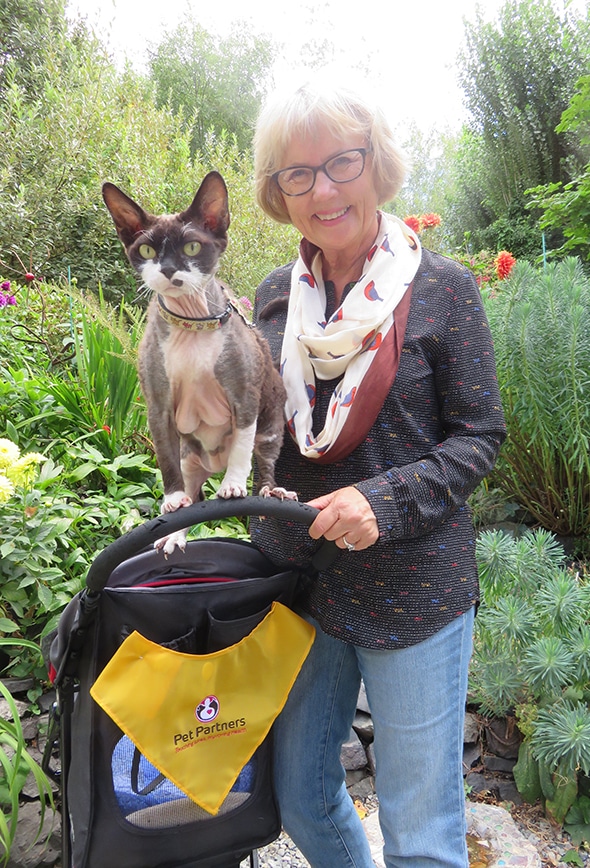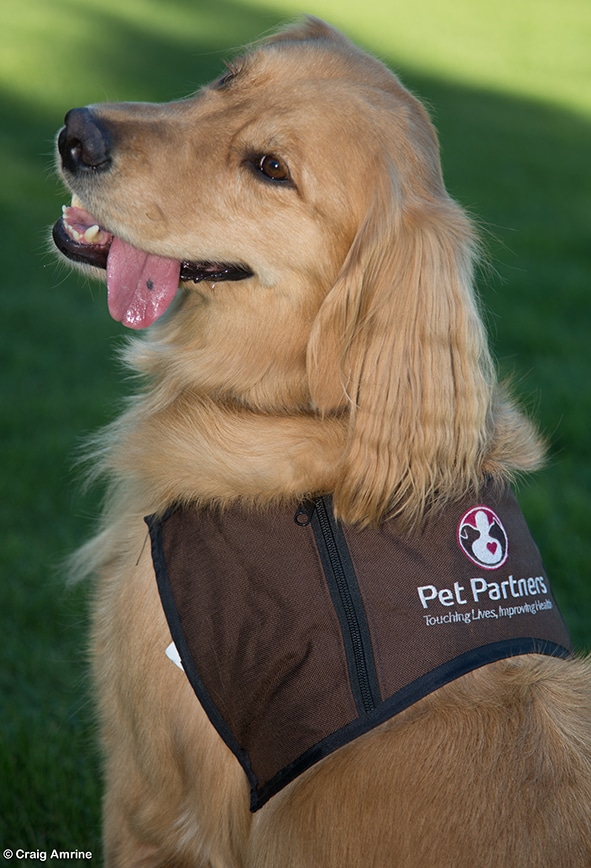Glossary
Learn the use and definitions of common industry and Pet Partners terms.


Learn the use and definitions of common industry and Pet Partners terms.



Animal-assisted activities provide opportunities for motivational, educational, and/or recreational benefits to enhance quality of life. While more informal in nature, these activities are delivered by a specially trained professional, paraprofessional, and/or volunteer, in partnership with an animal that meets specific criteria for suitability.
Animal-assisted crisis response is a form of animal-assisted activities which provides comfort to those who have been affected by natural, human-caused, or technological disasters. AACR is effective because the safety, familiarity, novelty, and interest in the animal have been found to be impactful when building rapport with a person affected by crisis.
Animal-assisted education is a goal-oriented, planned, and structured intervention directed by a general education or special education professional. The focus of the activities is on academic goals, prosocial skills, and cognitive functioning with student progress being both measured and documented.
Animal-assisted interventions are goal-oriented and structured interventions that intentionally incorporate animals in health, education, and human service for the purpose of therapeutic gains and improved health and wellness. Animal-assisted therapy (AAT), animal-assisted education (AAE), and animal-assisted activities (AAA) are all forms of animal-assisted interventions. In all these interventions, the animal may be part of a volunteer therapy animal team working under the direction of a professional or an animal that belongs to the professional.
Animal-assisted therapy is a goal-oriented, planned, structured, and documented therapeutic intervention directed by health and human service providers as part of their profession. A wide variety of disciplines may incorporate AAT. Possible practitioners could include physicians, occupational therapists, physical therapists, certified therapeutic recreation specialists, nurses, social workers, speech therapists, or mental health professionals.
When Pet Partners therapy animal teams make workplace well-being visits, they boost employee morale and satisfaction, and increase productivity. Numerous studies have shown that when people take just a few moments to pet an animal, their stress is reduced. Research also shows that animals in the workplace often lead to more productive coworker interaction, increased trust levels between colleagues, and more effective collaboration.
Animal-related engagement is any opportunity that allows participants the benefits of the human-animal bond by encouraging the remembrance of feelings that are commonly associated with interaction with an animal.
Assistance animals are defined as dogs and in some cases miniature horses that are individually trained to do work or perform tasks for people with disabilities. Examples include guide dogs for people who are blind, hearing dogs for people who are deaf, or dogs trained to provide mobility assistance or communicate medical alerts.
Assistance dogs are considered working animals, not pets. The work or task a dog has been trained to provide must be directly related to the person’s disability. Guide, hearing, and service dogs are permitted, in accordance with the Americans with Disabilities Act (ADA), to accompany a person with a disability almost anywhere the general public is allowed. This includes restaurants, businesses, and on airplanes.
We have a useful chart that gives a general overview of the differences between therapy, service/assistance, and emotional support animals. View or download.
An emotional support animal, sometimes also referred to as a comfort animal, is a pet that provides therapeutic support to a person with a mental illness. To be designated as an emotional support animal, the pet must be prescribed by a licensed mental health professional for a person with a mental illness. The prescription must state that the individual has an impairment that substantially limits one or more major life activities, and that the presence of the animal is necessary for the individual’s mental health.
Per the ADA, individuals with emotional support animals do not have the same rights to public access as individuals with a service dog. Emotional support animals may only accompany their owners in public areas with the express permission of each individual venue and/or facility management. Emotional support animals may live with their owners in locations covered by the Fair Housing Amendments Act (FHAA) regardless of a “no pets” policy. Although most frequently dogs, other species may be prescribed as emotional support animals.
We have a useful chart that gives a general overview of the differences between therapy, service/assistance, and emotional support animals. View or download.
A facility animal is a type of therapy animal who is regularly present in a residential, clinical, or educational setting. These animals may be a variety of species from dogs and cats to birds or fish. Depending on the species, the animal might live with a handler who is an employee of the facility and come to work each day, or they might live at the facility full-time under the care of a dedicated staff person. Facility animals should be specifically trained for extended interactions while also having the ability to rest and take breaks as needed. These animals do not have special rights of access in public unless they are accompanying and directly supporting a client with a disability.
Therapy animals can provide physical, psychological, and emotional benefits to those they interact with, typically in facility settings such as healthcare, assisted living, and schools. While most frequently dogs, therapy animals can include other domesticated species such as cats, equines, and rabbits, to name a few. These pets are evaluated on their ability to safely interact with a wide range of populations, and their handlers are trained in best practices to ensure effective interactions that support animal welfare. Therapy animal handlers may volunteer their time to visit with their animals in the community, or they may be practitioners who utilize the power of the human-animal bond in professional settings.
A therapy animal has no special rights of access, except in those facilities where they are welcomed. They may not enter businesses with “no pets” policies or accompany their handler in the cabin of an airplane regardless of their therapy animal designation.
*The terms AAI, AAT, AAE, and AAA are the preferred industry terms. The term ‘pet therapy’ should be avoided because it is inaccurate and misleading. The term was widely used several decades ago to refer to animal training programs. By contrast, the currently preferred terms imply that the animal is acting as a motivating force to enhance the treatment provided by a well-trained person.


The human end of the leash in a therapy animal team. The handler’s role is to support their animal during visits, advocate for their animal’s welfare, and ensure that visits are safe, effective, and enjoyable for everyone involved. Handlers complete the Pet Partners Handler Course to learn and deploy these skills.
The process through which a therapy animal team becomes part of the Pet Partners Therapy Animal Program. This process confirms that the team meets the requirements of our program and is suitable to participate in AAI. There is a distinction between registration and certification. Therapy animal teams are registered, not certified. Certification implies that an independent third party has assessed an individual’s mastery of knowledge and skills. For example, a doctor is certified by a Board of Medicine, not by the medical school where they completed their education. At this time, AAAIP offers an AAI Specialist Certification.
A series of exercises that gauge how the handler and animal perform in a simulation of a typical therapy animal visit. All handler-animal teams must pass the team evaluation, which consists of the Pet Partners Skills Test (PPST) and the Pet Partners Aptitude Test (PPAT). These must be administered by a Pet Partners licensed team evaluator.
A valued member of the Pet Partners family and a volunteer leader, who completes required prerequisite volunteer hours, coursework, discussion, and an in-person practicum to verify their suitability to conduct evaluations (in-person assessments) of prospective and renewing Pet Partners therapy animal teams.
A unique combination of one handler and one animal working together that registers through Pet Partners to participate in volunteer AAI in their community. Because Pet Partners believes in the importance of proactive handling for both animal welfare and client safety reasons, we emphasize the importance of balance between a skilled handler, an appropriate animal, and a positive, communicative relationship between the two. Our registration process is designed to assess this through a combination of coursework and evaluation.
A valued member of the Pet Partners family and a volunteer leader, who completes required training to lead an in-person workshop version of the Pet Partners Handler Course in their local community.
This stands for You Are Your Animal’s Best Advocate. YAYABA is your most important responsibility as a handler, because your animal’s welfare should always be your top priority.
